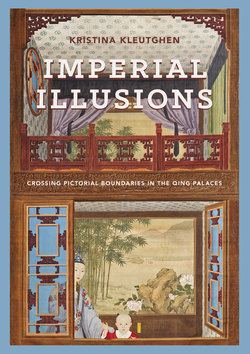Читать книгу Imperial Illusions - Kristina Kleutghen - Страница 57
На сайте Литреса книга снята с продажи.
Оглавлениеresponse specifically to perspectival images. Noting that Buglio made the paintings as large as possible, thereby increasing the illusionistic effects of their perspective, Verbiest commented,
Really, there comes no end to their admiration [when they see] how such deep backgrounds with roads, porches, courtyards, columns, and all other things can be conjured up on the absolutely flat surface of a canvas, and so close to reality that many of them—who have never seen or heard of such things before—were totally deluded when suddenly confronted at a fairly great distance with such paintings of houses and gardens and thought they were seeing real houses and gardens! . . . You can hardly believe how this art attracted everybody’s attention.77
Jean-Baptiste du Halde, S.J. (1674–1743), although not present at the event, also commented secondhand on how these works impressed the officials who saw them: “The Mandarins, who flock to this city from all parts, came to see them out of curiosity, and were all equally struck with the sight: they could not conceive how it was possible on a plain cloth to represent halls, galleries, porticoes, roads and alleys that seemed to reach as far as the eye could see, and all this so naturally that at the first sight they were deceived by it.”78 The paintings are not known to have survived, and there is no question that these comments are rife with the self-promoting rhetoric of the Jesuit mission. Nevertheless, they provide the first focused indication that High Qing viewers found perspectival paintings and their illusions of depth entirely legible.
Linear perspective so impressed Kangxi that he requested the Jesuits to send a trained European painter to Beijing to paint for him and to teach the technique to the court artists. Several European painters arrived in succession, but none left an impression on either the court or Chinese art until the 1699 arrival of the Modenese Jesuit lay brother Giovanni Gherardini (1655–1723?).79 With Gherardini, the court welcomed not just any perspective painter, but a student of Michelangelo Colonna (1604–87) and Agostino Mitelli (1609–60), Bolognese masters in the art of quadratura. Early Renaissance quadraturisti such as Andrea Mantegna (c. 1431–1506) first painted these deceptive works on the walls and ceilings of private residences, but during the sixteenth century quadratura spread to public spaces such as theaters, for which Andrea Palladio (1508–80) designed perspectival stage sets, and churches, for which Andrea Pozzo, S.J. (1642–1709), has been acclaimed as the “greatest of the ecclesiastical perspectivists.”80 Famous across Europe, Pozzo and his art were essential components of Jesuit propaganda and the global mission.81 The Apotheosis of St. Ignatius and the Society of Jesus (1688–94), Pozzo’s masterwork painted on the ceiling of the Jesuit mother church of Sant’Ignazio in Rome (figure. 1.8), is the paragon of quadratura painting because of its logical, consistent linkage of real and fictive architecture to create an extraordinary but believable vision that merges the physical and the spiritual.82
